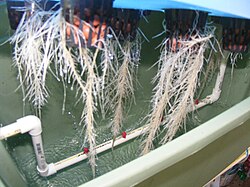Hydroculture
| A reader requests expansion of this book to include more material. You can help by adding new material (learn how) or ask for assistance in the reading room. |

This demonstrates the fundamentals and advanced topics of hydroculture gardening including: aquaponics, hydroponics, aquascaping/aquatic gardening, aeroponics, passive-hydroponics, plus hydroculture related gardening. Symbiotic aquatic animals are for ornamental purposes, since this book's focus is horticultural.
Food production for consumption, medicinal value and horticultural aesthetics are purposes for building a hydroculture garden. Also included are root zone and aeration basics, along with plant nutrition fundamentals. Ranging in this book is from low cost simple ways to highly complex expensive ways of growing soil-less or water-based gardening. Projects can be used for self-sustainability to reducing food costs, supplementing food, medicinal implementation, aesthetic value or growing food where there is scarcity of resources or income (for example in developing nations).
There is a section on DIY hydroculture projects. The easiest method of maintaining the nutrient solution is to use aquaponics, which can be combined with any other form of hydroculture. Other methods may leave little room for error, and may require expertise in automation, measuring equipment, maintenance and chemistry knowledge.
Contents
[edit | edit source]
Section 1 - Introduction
Section 2 - Physiology
 Root zone
Root zone- Aeration
- Disease - Prevention, phytopathology, root rot
- Substrates
 Propagation
Propagation Aquatic organisms - Aquaculture subsystem: aquaponics, aquascaping. hydrophytes, semi-aquatic plants, symbiotic animals.
Aquatic organisms - Aquaculture subsystem: aquaponics, aquascaping. hydrophytes, semi-aquatic plants, symbiotic animals.
Section 3 - Plant nutrition
Section 4 - Construction projects
- Project construction basics
- Aeroponic bucket
- Simple aquaponics setup
- Aquaponic cylinder bin
 Growbed construction
Growbed construction- Passive hydroponic setup
- Passive hydroponics for orchid cultivation
- Nonmechanical biofilters
Only pages that are largely incomplete are marked. Pages that are 75% percent or more complete are not marked.
